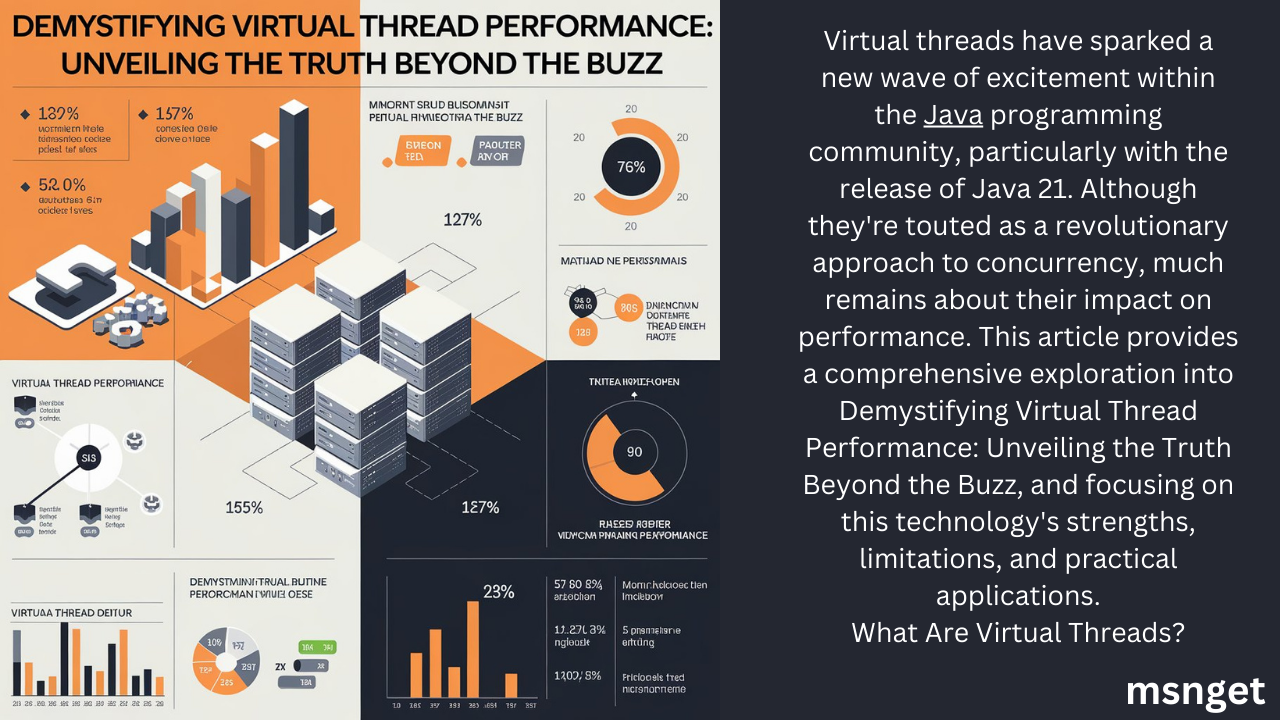

Demystifying Virtual Thread Performance: Unveiling the Truth Beyond the Buzz
Virtual threads have sparked a new wave of excitement within the Java programming community, particularly with the release of Java 21. Although they’re touted as a revolutionary approach to concurrency, much remains about their impact on performance. This article provides a comprehensive exploration into Demystifying Virtual Thread Performance: Unveiling the Truth Beyond the Buzz, and focusing on this technology’s strengths, limitations, and practical applications.
What Are Virtual Threads?
Virtual threads, often called “green threads” or “fibers,” are lightweight, user-managed threads designed by the JVM to reduce the overhead of traditional threads. Unlike traditional threads, virtual threads are not tied directly to operating system threads. This independence allows them to execute with less resource consumption, particularly in high-concurrency environments. But how do they genuinely affect performance?
Key Benefits of Virtual Threads
Virtual threads offer several advantages over traditional threads, especially for developers seeking high-concurrency solutions. Here’s a breakdown of some critical benefits:
- Lower Resource Consumption
- Unlike traditional threads, virtual threads require fewer system resources, making it possible to handle thousands (or even millions) of concurrent tasks without burdening the system.
- Simplified Programming Model
- Virtual threads allow developers to write blocking-style code, simplifying complex asynchronous logic. This improves code readability and reduces the learning curve for developers unfamiliar with asynchronous programming.
- Enhanced Scalability
- Applications utilizing virtual threads can achieve high concurrency, making them well-suited for scenarios that demand rapid response times and large-scale task handling.

While these benefits sound promising, they are only sometimes applicable. Virtual threads can excel in some situations yet have minimal impact in others. Let’s explore the types of workloads where virtual threads shine and those where traditional threads may still hold the advantage.
Where Virtual Threads Excel: I/O-Bound Workloads
Virtual threads significantly enhance throughput and responsiveness for applications handling frequent I/O operations, such as web requests or database queries. Virtual threads are exceptionally efficient in scenarios where tasks spend much time waiting for external responses. Rather than blocking traditional threads and consuming valuable resources, virtual threads can efficiently handle waiting time, freeing up system capacity for other operations. This leads to a smoother, faster experience for the end-user without straining system resources.
Also Read: This Blog Will Show You About The New Digital Technology In Thailand
Virtual Threads vs. CPU-Bound Tasks
Regarding CPU-bound workloads—tasks that require constant processing power—virtual threads may not deliver the same performance boost. CPU-bound tasks involve continuous computation and less waiting, so the benefits of the lightweight, non-blocking nature of virtual threads are limited. In such cases, traditional platform threads, which can manage more intensive processing with better utilization of CPU resources, might be more effective.

The takeaway? Virtual threads work best when tasks spend much time in a waiting state rather than when processing power is heavily consumed.
Considerations for Garbage Collection and Resource Overhead
High concurrency has implications for garbage collection. Since virtual threads allow for many concurrent tasks, garbage collection demands can rise, especially when handling frequent thread creation and termination. Developers must be mindful of this potential overhead, as increased garbage collection can slow down the entire application.
To mitigate this, developers should monitor garbage collection activity in virtual thread-based applications and, if necessary, fine-tune the garbage collection settings for optimal performance. Balancing garbage collection and virtual thread performance requires a careful approach, particularly in resource-intensive applications.
Compatibility with Existing Libraries and Frameworks
Not all Java frameworks and libraries are fully optimized for virtual threads. Some libraries, designed with traditional threads in mind, may encounter compatibility issues or performance bottlenecks when used with virtual threads.
To ensure compatibility, developers should check whether their chosen libraries are updated for virtual threads and confirm that they utilize thread-pooling or other features optimized for lightweight, high-concurrency threading. Selecting compatible tools will enhance application performance and prevent unexpected bottlenecks.
Real-World Performance Implications
The performance of virtual threads varies depending on real-world application requirements. Here’s how virtual threads perform across different workload types:

- I/O-Bound Workloads
- Virtual threads have proven to improve throughput and reduce latency in applications where tasks predominantly wait for I/O responses, such as microservices handling multiple requests.
- CPU-Bound Workloads
- While virtual threads can process CPU-bound tasks, they don’t significantly outperform traditional threads in this scenario. They may struggle under intense CPU demands if the functions are highly computational.
- Mixed Workloads
- Applications that combine I/O and CPU-bound tasks can benefit from a hybrid approach, utilizing virtual threads for waiting periods and traditional threads for intense processing segments.
Best Practices for Maximizing Virtual Thread Performance
To get the most out of virtual threads, it’s essential to adopt the following practices:
- Identify Suitable Tasks
- Reserve virtual threads for I/O-bound or high-concurrency tasks while leveraging traditional threads for CPU-bound operations.
- Optimize Thread Pools
- Although virtual threads are efficient, they require careful thread-pool configuration to manage system resources effectively. Aim to strike a balance that minimizes resource usage while maximizing concurrency.
- Use Compatible Libraries
- Confirm that your application’s libraries and frameworks are updated and optimized for virtual threads. Testing is essential to avoid performance lags and compatibility issues.
- Monitor and Adjust Performance
- Regularly monitor key performance metrics, especially in high-concurrency applications. Fine-tuning settings based on performance insights will help optimize resource use and keep your application running smoothly.
Unveiling the Truth: Are Virtual Threads Overhyped?
After a thorough exploration, it’s clear that Demystifying Virtual Thread Performance: Unveiling the Truth Beyond the Buzz requires a realistic perspective. Virtual threads are transformative for I/O-heavy, concurrent applications, offering significant simplicity, scalability, and responsiveness benefits. However, the benefits are less pronounced for CPU-intensive tasks or situations where existing thread management solutions perform well.
In other words, while virtual threads provide an invaluable tool in specific contexts, they only partially replace traditional threading models. Developers must evaluate their workload needs and choose the threading model that best aligns with their application’s requirements.
Final Thoughts
Demystifying Virtual Thread Performance: Unveiling the Truth Beyond the Buzz Virtual threads have introduced an exciting new paradigm for Java developers, providing a fresh approach to managing concurrency with reduced complexity and improved scalability. They offer a significant performance advantage for applications that rely on high concurrency or handle extensive I/O tasks. Yet, the benefits may be more limited for CPU-intensive applications.
Incorporating virtual threads into your Java applications can lead to remarkable improvements in responsiveness and scalability, provided you take a mindful, balanced approach to workload management. As more frameworks optimize for this new technology, virtual threads will likely become a mainstay in concurrent Java programming, offering developers the flexibility to create powerful, efficient applications.
By embracing virtual threads’ strengths and understanding their limitations, you can make informed decisions that harness this technology’s best features.














